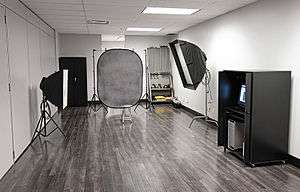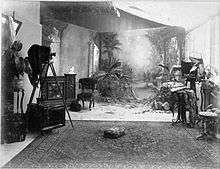Photographic studio


A photographic studio (also known as a photography studio or photo studio) is a workspace to take, develop, print and duplicate photographs. Photographic training and the display of finished photographs may also be accommodated in a photographic studio. The studio may have a darkroom, storage space, a studio proper where photographs are taken, a display room and space for other related work.
A photographic studio is often a business owned and represented by one or more photographers, possibly accompanied by assistants and pupils, who create and sell their own and sometimes others’ photographs.
Since the early years of the 20th century the business functions of a photographic studio have increasingly been called a “photographic agency,” leaving the term “photographic studio” to refer almost exclusively to the workspace.
The history of photographic studios and photography dates back to 19th century with the first camera making an appearance. The earliest photographic studios made use of painters' lighting technique to create photographic portraits. During that era the nothing was better than the sunlight with open window as the primary source of light of painters.
However Lately photographers adapted these techniques. Did anyone hear about Julia Margaret Cameron? Born in Kolkatta, she was the person who applied the principle of fine art to photography using available light in a studio just like painters did. However at that time photography came with many disadvantages if compared to portrait painting. It was possible to create only black and white images. With few advancement photography suffered until 1850s because of the high cost color films and processing. Very few could afford it so photographic studios weren't much into lime light.
People tried many things from time to time when setting up studios to cope up with different hurdles in photography. However lighting was a big hurdle at those times. Flash powder was the first means of artificial lighting that allowed to produce sufficient brightness to capture the action of the film . However this industry developed at a faster rate. With advancement in camera lenses, lighting and other techniques and equipment, studio photography gained hold and it became quite easier to produce images within a studio.
During 30s celluloid films replaced glass plates. ISO increased progressively over the next 20 years. Photographic studios started using flashes in 1840. However, not everyone could afford it as they were quite expensive and dangerous. These flashes were also known as 'hot lights' and could have exploded. By 1860s they were in common use in professional studios. 'Tungsten Lights' or 'Hot Lights' were still in use. In around 70s even smaller studios got access to flash lights or strobes.
The first commercial use of photography was in the production of portraits. Photography replaced painting completely by 40s. with fully equipped studios in existence. The photography process was much shorter and simple as compared to painting, in which the subject and even the painter used to suffer.
'Calotypes' was introduced in 1840s. With the introduction of calotypes the production of negative enabled the photographers to print as many copies as customer required, hence strengthening the very base for the studios. In 1850s small portraits called 'Ambrotypes' were being produced. The exposure time varied between 2 and 20 seconds in comparison to 8 hr long exposure when the first still portrait photograph was takenin 1826. With the time passing by, saw the advancement in the photography. However, trick photography has always been around from as long as photography is. Trick photography was later replaced by Photoshop.
It became easy and cheap to set up the photographic studios. Modern studios are equipped with new age lighting, gears and technology. They are capable of producing high quality images in bulk. From the past 15 years the studio setup has changed drastically and still getting more digital.
Gallery
 Photography studio with green screen backdrop.
Photography studio with green screen backdrop. Studio arrangement for product photography and video.
Studio arrangement for product photography and video.
References
| Wikimedia Commons has media related to Photographic studios. |
- Art & Architecture Thesaurus, s.v. "studios (organizations)". Accessed 31 January 2008.
- Art & Architecture Thesaurus, s.v. "studios (work spaces)". Accessed 31 January 2008.
- Evolution Of Photographic Studios